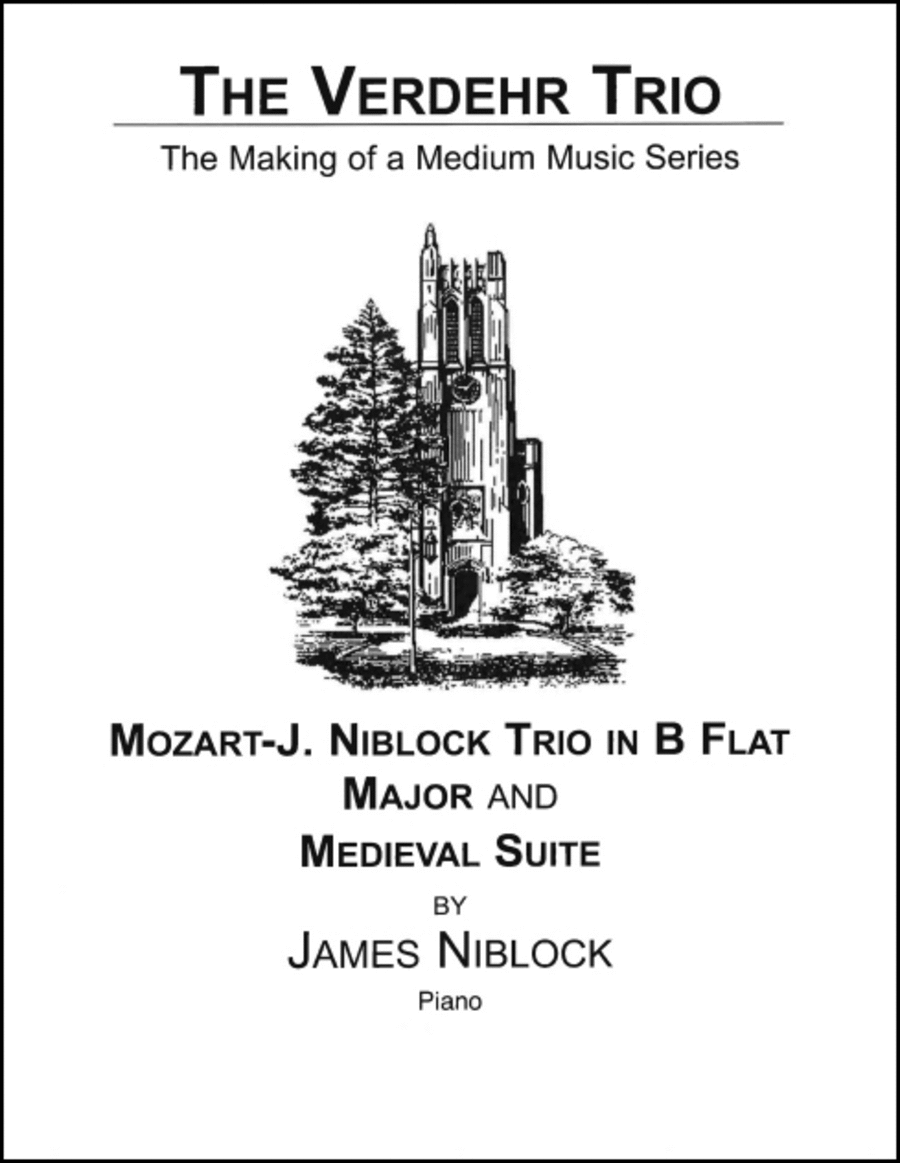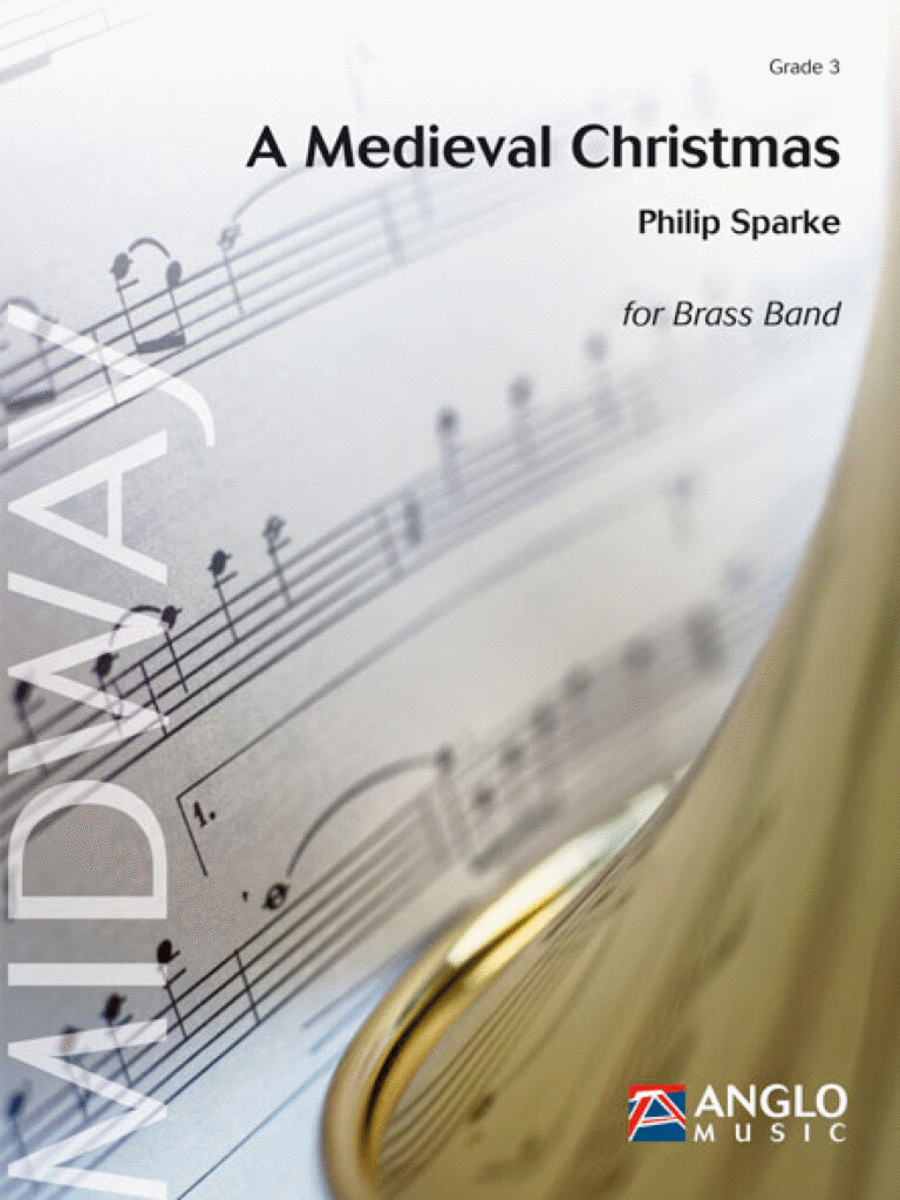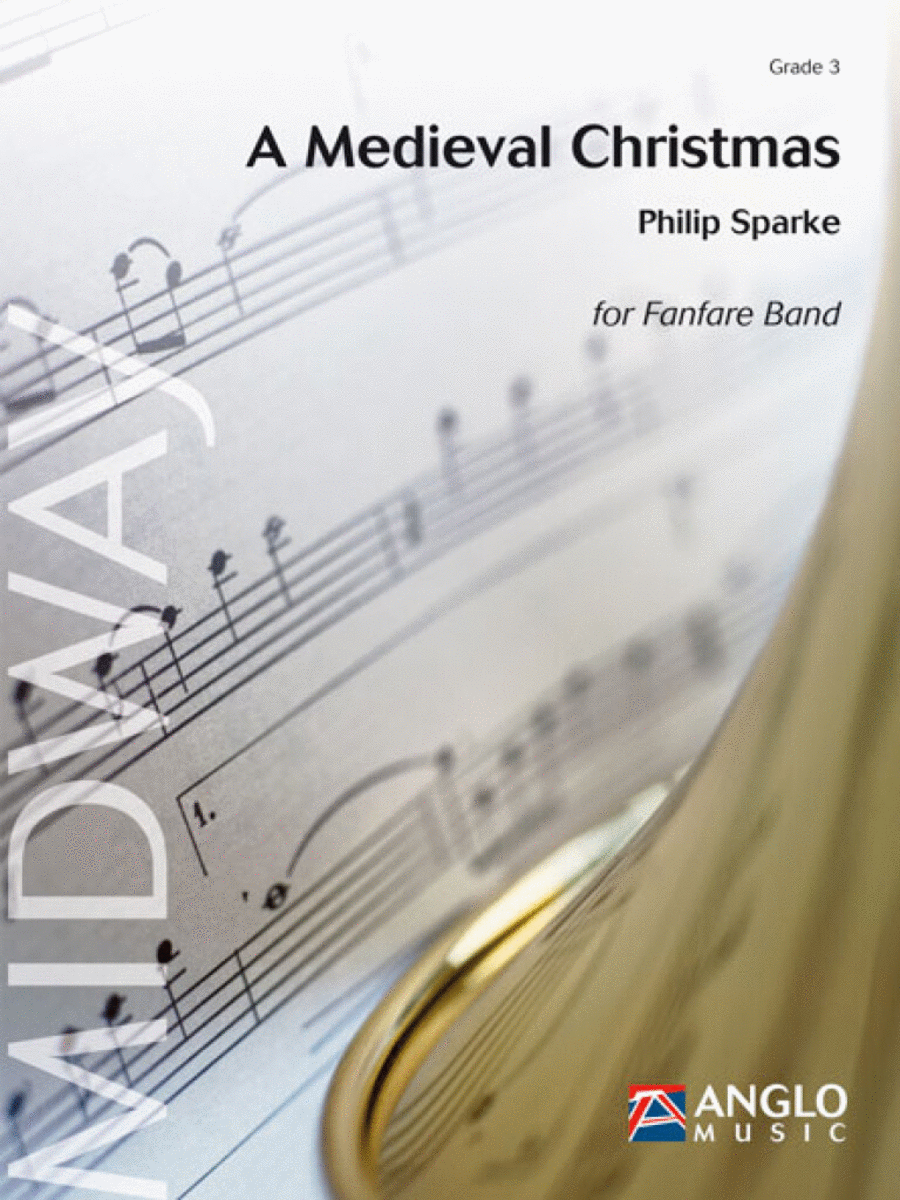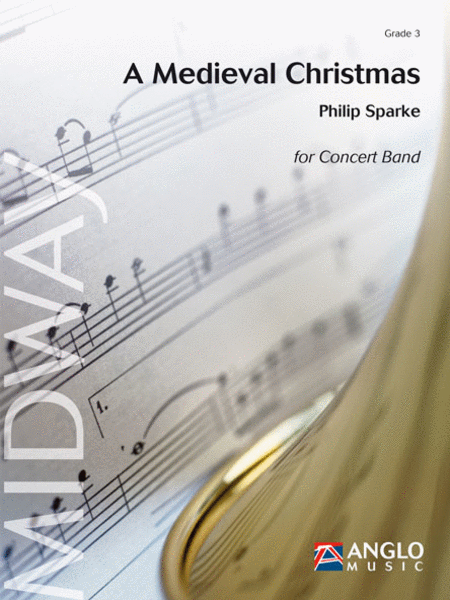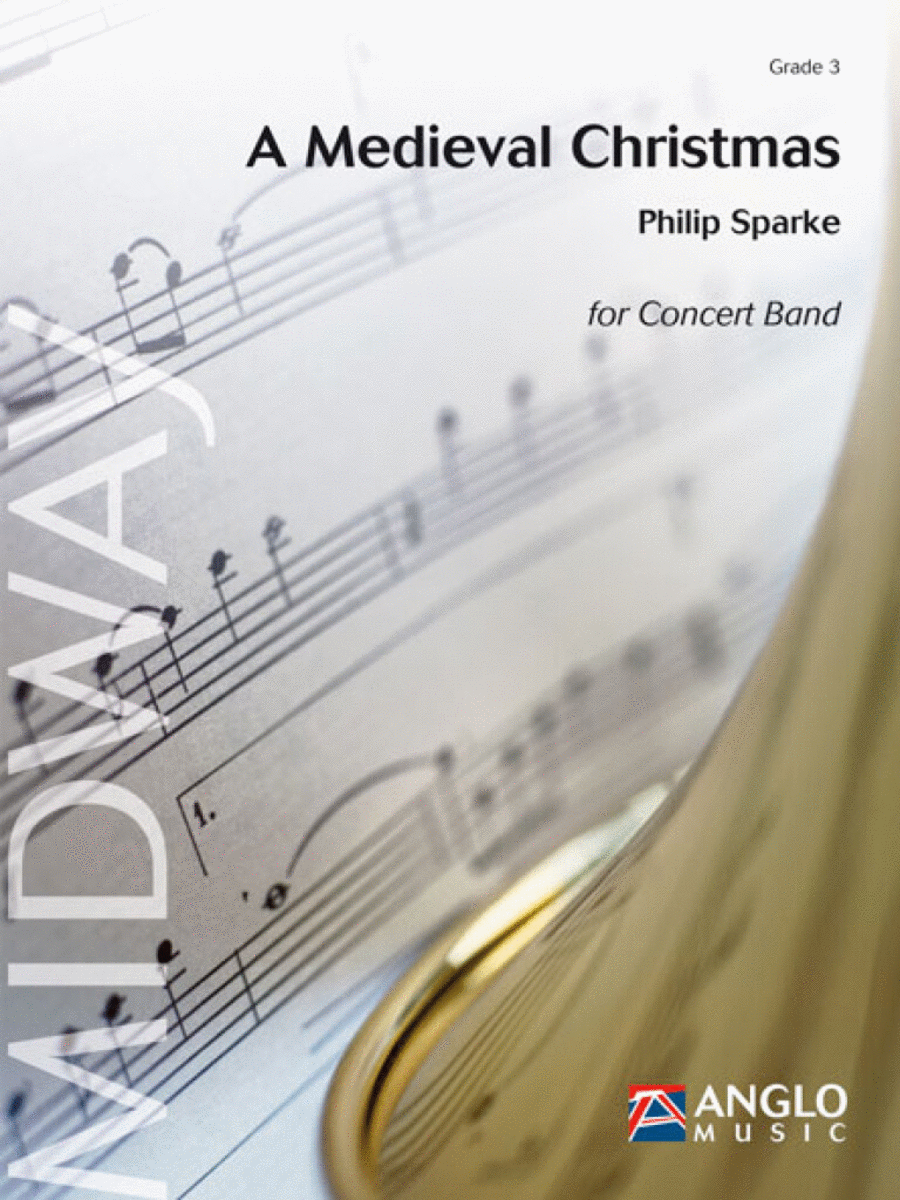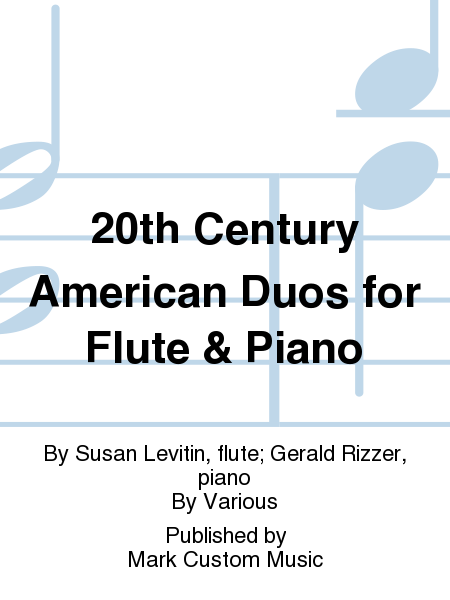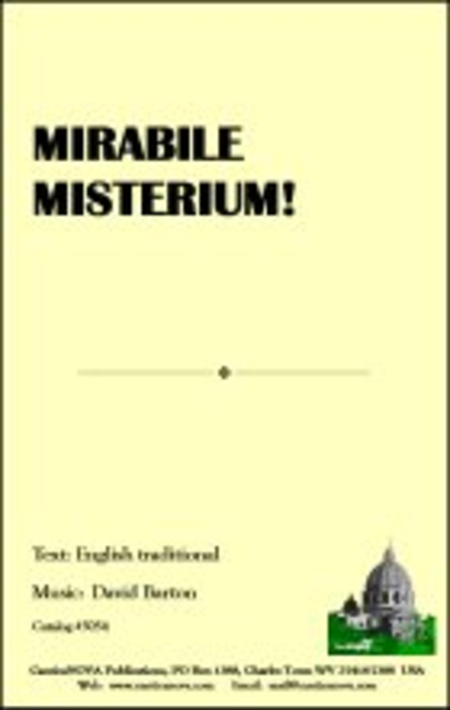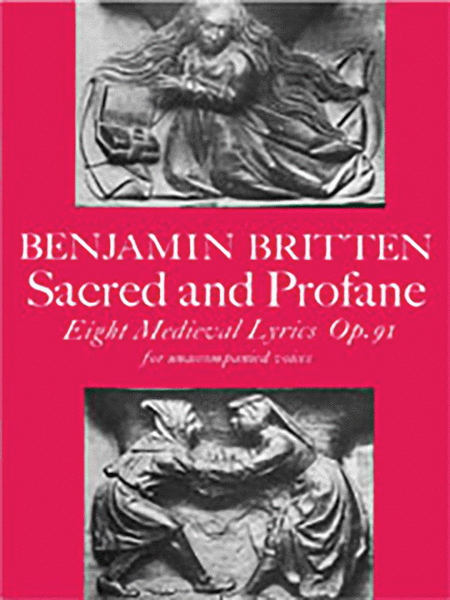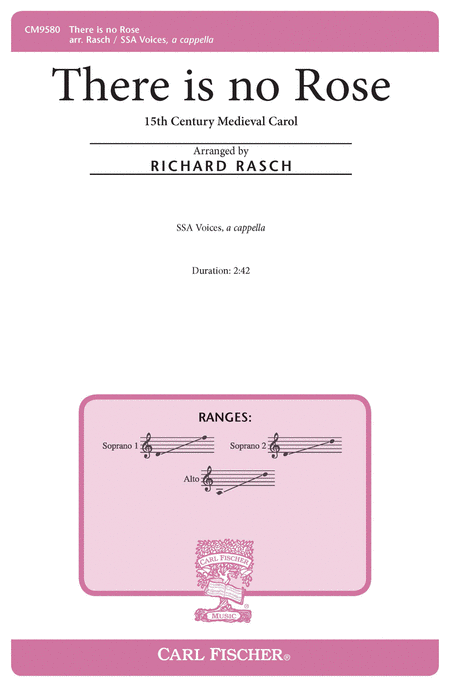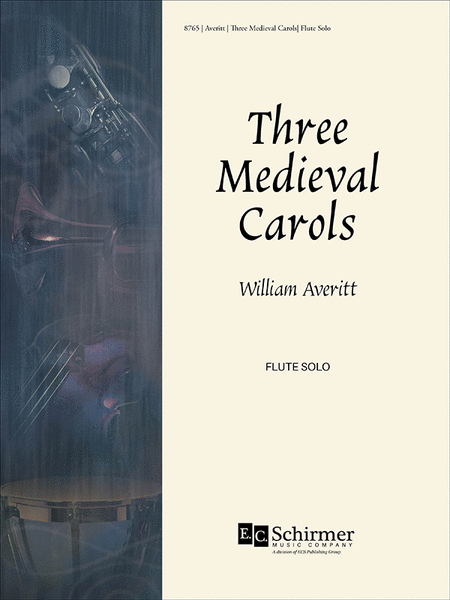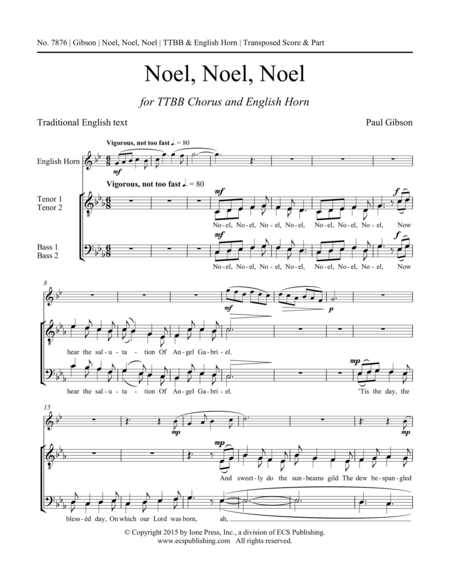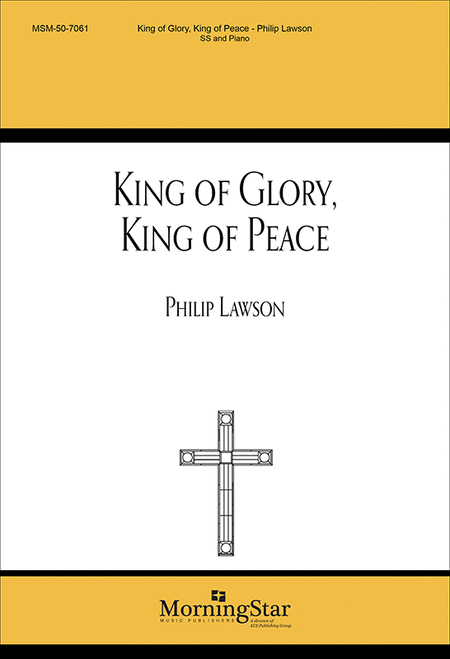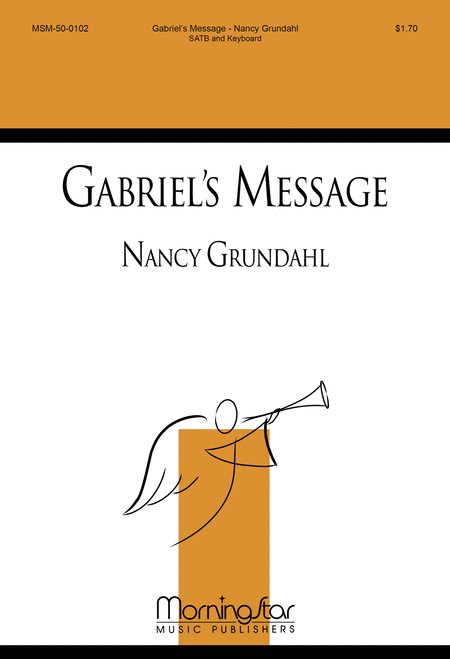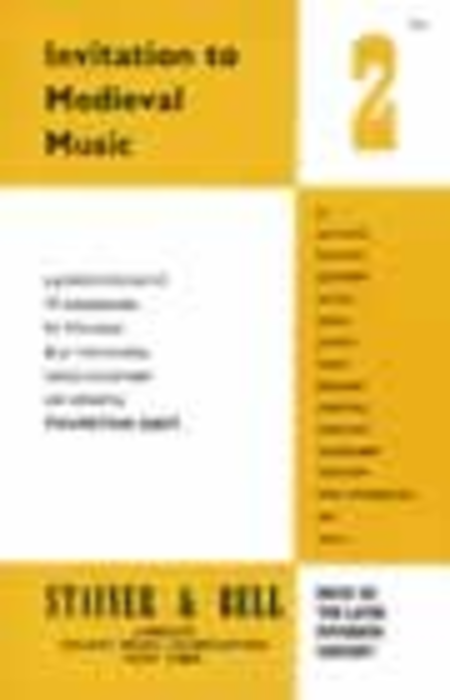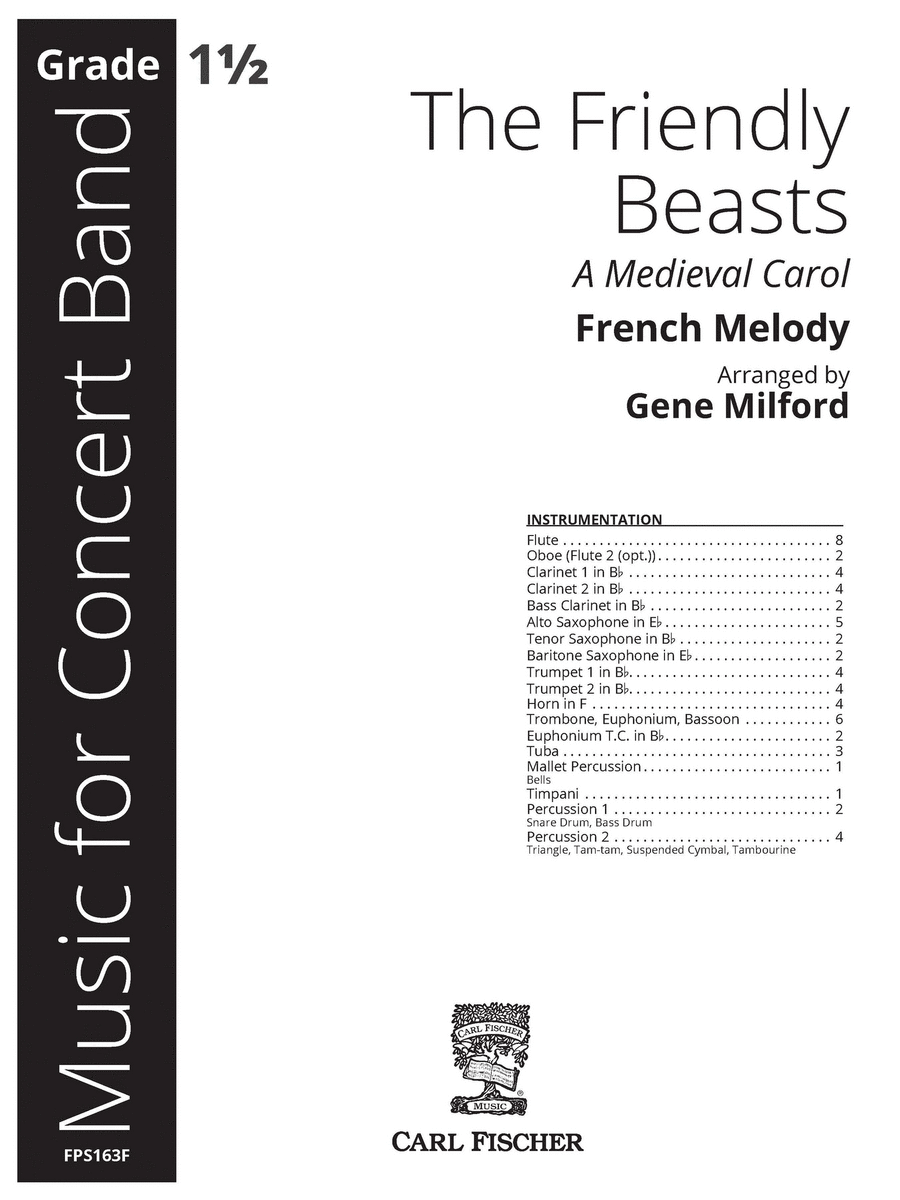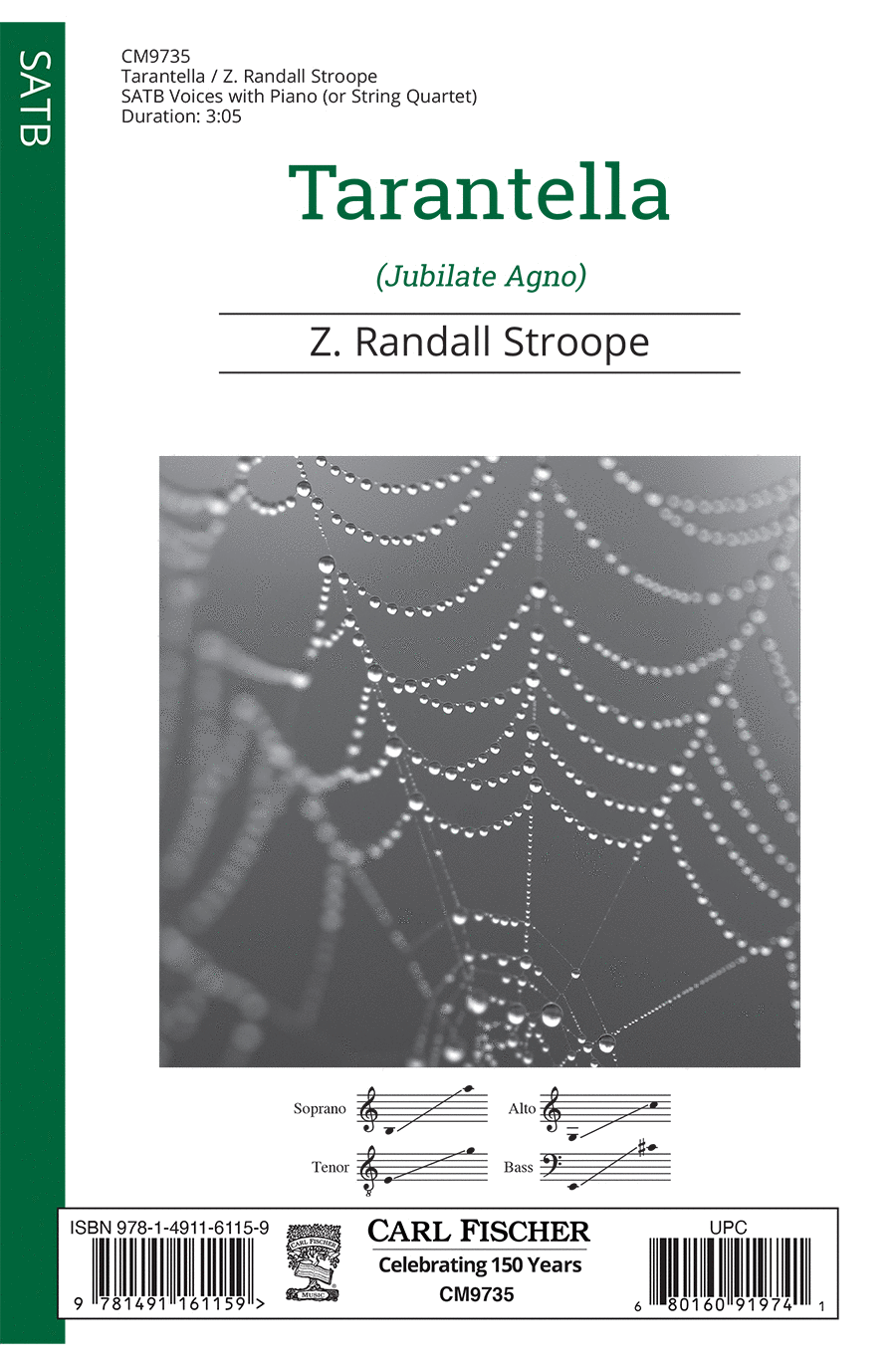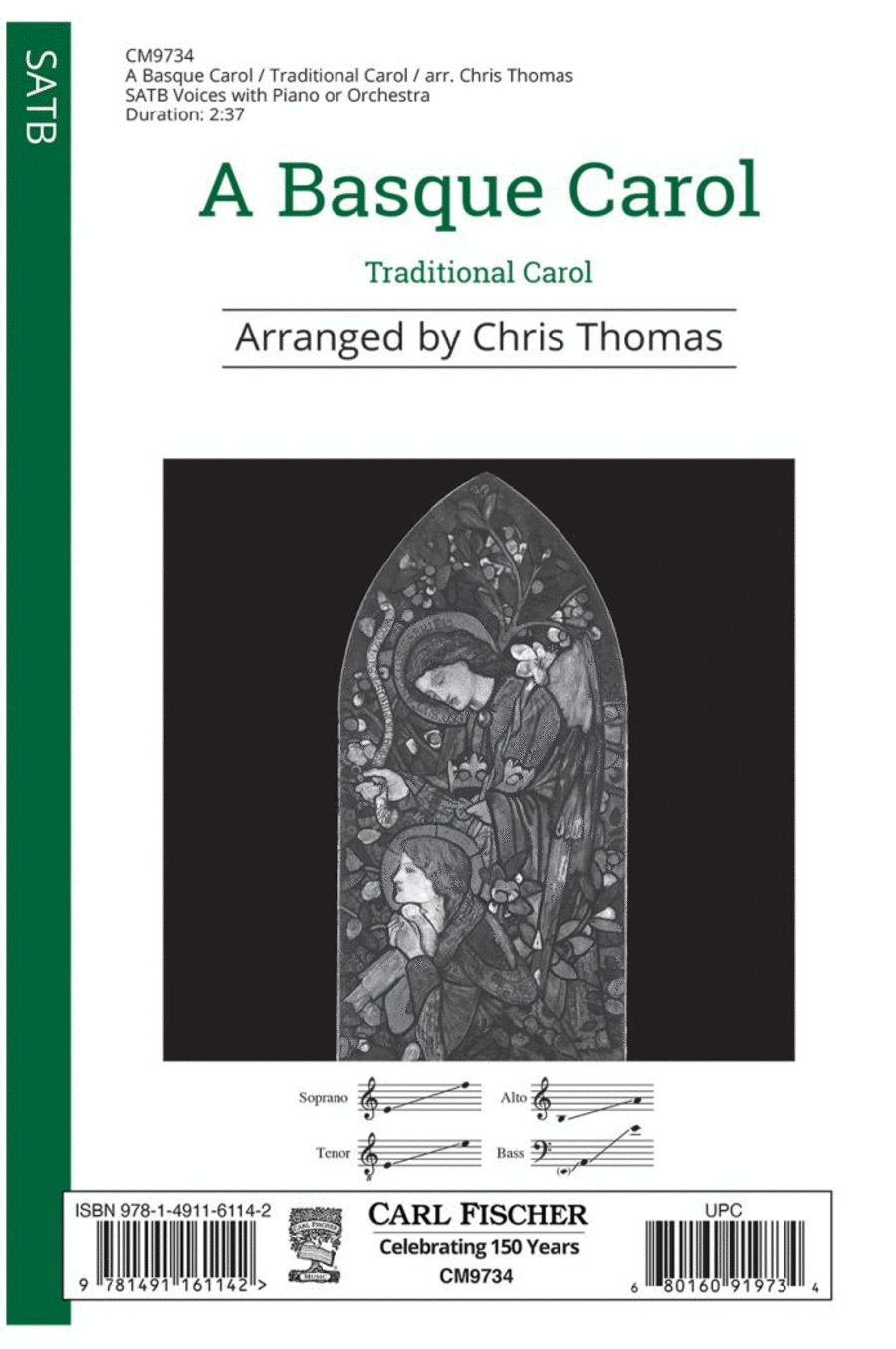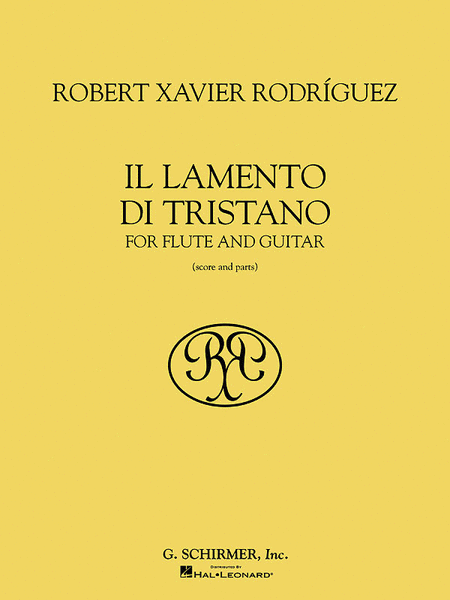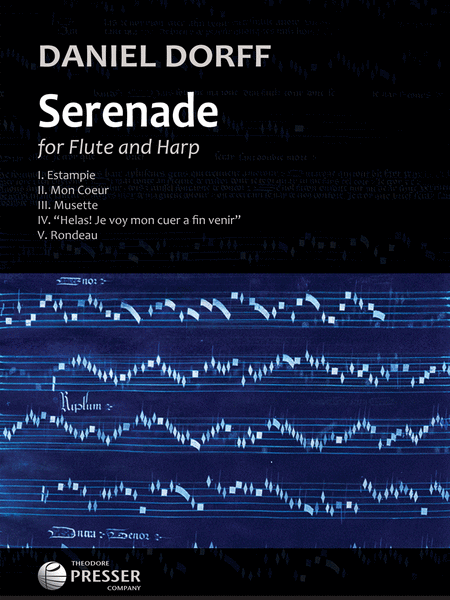|
| Trio in B Flat Major (Mozart) and Medieval Suite
Violon, Clarinette, Piano (trio) [Conducteur et Parties séparées]
Subito Music
Clarinet, Violin & Piano SKU: SU.46200010 For Clarinet, Violin & Piano...(+)
Clarinet, Violin & Piano
SKU: SU.46200010
For Clarinet, Violin &
Piano. Composed by
James Niblock. Chamber
Music, Piano Trio,
Woodwinds, Clarinet.
Score & Parts. Subito
Music Corporation
#46200010. Published by
Subito Music Corporation
(SU.46200010).
Clarinet,
Violin & Piano Duration:
25 ' Composed: 1984
Published by: Verdehr
Trio This publication
contains two separate
worksMedieval Suite
composed by James
NiblockTrio in B-flat
transcribed by James
Niblock Medieval Suite
uses material from a
variety of thirteenth
through fifteenth-century
sources. The second
movement is a fantasy for
clarinet solo based on a
Gregorian Chant melody
from the Liber Usualis.
Trio in Bb Major, K358 is
a transcription on one of
four piano sonatas that
Mozart composed for four
hands. The objective of
this transcription was to
capture, as accurately as
possible, Mozart’s
intent had he scored this
sonata of the trio.
Michigan State University
Press. $95.00 - Voir plus => AcheterDélais: 2 to 3 weeks | | | |
| A Medieval Christmas
Ensemble de cuivres [Conducteur et Parties séparées] - Facile
Anglo Music
Brass Band - Grade 3 SKU: BT.AMP-324-030 Composed by Philip Sparke. Anglo...(+)
Brass Band - Grade 3
SKU:
BT.AMP-324-030
Composed by Philip
Sparke. Anglo Music
Midway Series. Set (Score
& Parts). Composed 2011.
Anglo Music Press #AMP
324-030. Published by
Anglo Music Press
(BT.AMP-324-030). 9x12
inches.
English-German-French-Dut
ch. Christmas is
full of customs and
traditions, both old and
new. This is especially
evident in Christmas
songs, some of which have
been part of Christian
worship for centuries.
A Medieval
Christmas combines
three ancient melodies
that are stillpopular
around the world today.
Philip Sparke chose
Gaudete, a song of
praise from the middle
ages, Coventry
Carol, an English
song from the 14th
century, and In dulci
jubilo, which can
also be traced back to
the 14th century, toform
this joyous
suite.
Kerst is
een feest van tradities
en gebruiken. Dit komt
vooral naar voren uit de
kerstliederen die al
eeuwenlang een centrale
plaats innemen binnen de
christelijke cultuur. In
A Medieval
Christmas staan drie
oude melodieën
centraal diewereldwijd
nog steeds populair zijn.
Het zijn het middeleeuwse
loflied Gaudete,
het Engelse Coventry
Carol en het bekende
In dulci
jubilo.
Weihna
chten ist auch ein Fest
des Brauchtums und der
Tradition. Dies zeigt
sich ganz besonders in
den Weihnachtsliedern,
die oft schon seit
Jahrhunderten einen
zentralen Platz in der
christlichen Kultur
einnehmen. A Medieval
Christmasverwendet
drei dieser alten
Melodien, die sich heute
noch weltweit
größter Beliebtheit
erfreuen: das
mittelalterliche Loblied
Gaudete, das
englische Coventry
Carol aus dem 14.
Jahrhundert und das
bekannte In dulci
jubilo, dasebenfalls
auf das 14. Jahrhundert
zurückgeht.
Dan
s de nombreux pays,
Noël est un moment
privilégié,
célébré par de
nombreux chants et
mélodies dont beaucoup
constituent un
élément central du
culte chrétien. Le
fait que ces chants
anciens subsistent depuis
si longtemps témoigne
de leur attraitimmuable,
formant un lien tangible
avec les festivités de
Noël qui se
déroulaient il y a des
centaines d'années.
A Medieval
Christmas emprunte
trois de ces ancestrales
mélodies, demeurées
populaires dans le monde
entier :
Gaudete,Coventry
Carol, et In Dulci
Jubilo.
Il
Natale é la festa
delle tradizioni e ciò
si riscontra facilmente
nei canti natalizi che da
secoli occupano un posto
di primo piano nella
tradizione cristiana.
A Medieval
Christmas propone tre
antiche melodie, ancora
oggi moltoattuali: il
canto di lode Gaudete,
Coventry Carol e
In Dulci Jubilo,
entrambe del XIV
secolo. $95.95 - Voir plus => AcheterDélais: 2 to 3 weeks | | | |
| A Medieval Christmas
Fanfare [Conducteur et Parties séparées] - Facile
Anglo Music
Fanfare Band - Grade 3 SKU: BT.AMP-324-020 Composed by Philip Sparke. Ang...(+)
Fanfare Band - Grade 3
SKU:
BT.AMP-324-020
Composed by Philip
Sparke. Anglo Music
Midway Series. Set (Score
& Parts). Composed 2011.
Anglo Music Press #AMP
324-020. Published by
Anglo Music Press
(BT.AMP-324-020). 9x12
inches.
English-German-French-Dut
ch. Christmas is
full of customs and
traditions, both old and
new. This is especially
evident in Christmas
songs, some of which have
been part of Christian
worship for centuries.
A Medieval
Christmas combines
three ancient melodies
that are stillpopular
around the world today.
Philip Sparke chose
Gaudete, a song of
praise from the middle
ages, Coventry
Carol, an English
song from the 14th
century, and In dulci
jubilo, which can
also be traced back to
the 14th century, toform
this joyous
suite.
Kerst is
een feest van tradities
en gebruiken. Dit komt
vooral naar voren uit de
kerstliederen die al
eeuwenlang een centrale
plaats innemen binnen de
christelijke cultuur. In
A Medieval
Christmas staan drie
oude melodieën
centraal diewereldwijd
nog steeds populair zijn.
Het zijn het middeleeuwse
loflied Gaudete,
het Engelse Coventry
Carol en het bekende
In dulci
jubilo.
Weihna
chten ist auch ein Fest
des Brauchtums und der
Tradition. Dies zeigt
sich ganz besonders in
den Weihnachtsliedern,
die oft schon seit
Jahrhunderten einen
zentralen Platz in der
christlichen Kultur
einnehmen. A Medieval
Christmasverwendet
drei dieser alten
Melodien, die sich heute
noch weltweit
größter Beliebtheit
erfreuen: das
mittelalterliche Loblied
Gaudete, das
englische Coventry
Carol aus dem 14.
Jahrhundert und das
bekannte In dulci
jubilo, dasebenfalls
auf das 14. Jahrhundert
zurückgeht.
Dan
s de nombreux pays,
Noël est un moment
privilégié,
célébré par de
nombreux chants et
mélodies dont beaucoup
constituent un
élément central du
culte chrétien. Le
fait que ces chants
anciens subsistent depuis
si longtemps témoigne
de leur attraitimmuable,
formant un lien tangible
avec les festivités de
Noël qui se
déroulaient il y a des
centaines d'années.
A Medieval
Christmas emprunte
trois de ces ancestrales
mélodies, demeurées
populaires dans le monde
entier :
Gaudete,Coventry
Carol, et In Dulci
Jubilo.
Il
Natale é la festa
delle tradizioni e ciò
si riscontra facilmente
nei canti natalizi che da
secoli occupano un posto
di primo piano nella
tradizione cristiana.
A Medieval
Christmas propone tre
antiche melodie, ancora
oggi moltoattuali: il
canto di lode Gaudete,
Coventry Carol e
In Dulci Jubilo,
entrambe del XIV
secolo. $140.95 - Voir plus => AcheterDélais: 2 to 3 weeks | | | |
| A Medieval Christmas
Orchestre d'harmonie [Conducteur] - Facile
Anglo Music
Concert Band/Harmonie - Grade 3 SKU: BT.AMP-324-140 Composed by Philip Sp...(+)
Concert Band/Harmonie -
Grade 3 SKU:
BT.AMP-324-140
Composed by Philip
Sparke. Anglo Music
Midway Series. Festive
and Solemn Music. Score
Only. Composed 2011. 32
pages. Anglo Music Press
#AMP 324-140. Published
by Anglo Music Press
(BT.AMP-324-140). 9x12
inches.
English-German-French-Dut
ch. Christmas is
full of customs and
traditions, both old and
new. This is especially
evident in Christmas
songs, some of which have
been part of Christian
worship for centuries. A
Medieval Christmas
combines three ancient
melodies that are still
popular around the world
today. Philip Sparke
chose Gaudete, a song of
praise from the middle
ages, Coventry Carol, an
English song from the
14th century, and In
dulci jubilo, which can
also be traced back to
the 14th century, to form
this joyous
suite.
Kerst is
een feest van tradities
en gebruiken. Dit komt
vooral naar voren uit de
kerstliederen die al
eeuwenlang een centrale
plaats innemen binnen de
christelijke cultuur. In
A Medieval Christmas
staan drie oude
melodieën centraaldie
wereldwijd nog steeds
populair zijn. Het zijn
het middeleeuwse loflied
Gaudete, het Engelse
Coventry Carol en het
bekende In dulci
jubilo.
Weihnachte
n ist auch ein Fest des
Brauchtums und der
Tradition. Dies zeigt
sich ganz besonders in
den Weihnachtsliedern,
die oft schon seit
Jahrhunderten einen
zentralen Platz in der
christlichen Kultur
einnehmen. A Medieval
Christmas verwendet
drei dieser alten
Melodien, die sich heute
noch weltweit
größter Beliebtheit
erfreuen: das
mittelalterliche Loblied
Gaudete, das
englische Coventry
Carol aus dem 14.
Jahrhundert und das
bekannte In dulci
jubilo, das ebenfalls
auf das 14. Jahrhundert
zurückgeht.
Dan
s de nombreux pays,
Noël est un moment
privilégié,
célébré par de
nombreux chants et
mélodies dont beaucoup
constituent un
élément central du
culte chrétien. Le
fait que ces chants
anciens subsistent depuis
si longtemps témoigne
de leur attrait immuable,
formant un lien tangible
avec les festivités de
Noël qui se
déroulaient il y a des
centaines
d’années. A
Medieval Christmas
emprunte trois de ces
ancestrales mélodies,
demeurées populaires
dans le monde entier :
Gaudete, Coventry Carol,
et In Dulci
Jubilo.
Il Natale
è la festa delle
tradizioni e ciò si
riscontra facilmente nei
canti natalizi che da
secoli occupano un posto
di primo piano nella
tradizione cristiana. A
Medieval Christmas
propone tre antiche
melodie, ancora oggi
molto attuali: il canto
di lode Gaudete, Coventry
Carol e In Dulci Jubilo,
entrambe del XIV
secolo. $34.95 - Voir plus => AcheterDélais: 2 to 3 weeks | | | |
| A Medieval Christmas
Orchestre d'harmonie [Conducteur et Parties séparées] - Facile
Anglo Music
Concert Band/Harmonie - Grade 3 SKU: BT.AMP-324-010 Composed by Philip Sp...(+)
Concert Band/Harmonie -
Grade 3 SKU:
BT.AMP-324-010
Composed by Philip
Sparke. Anglo Music
Midway Series. Set (Score
& Parts). Composed 2011.
Anglo Music Press #AMP
324-010. Published by
Anglo Music Press
(BT.AMP-324-010). 9x12
inches.
English-German-French-Dut
ch. Christmas is
full of customs and
traditions, both old and
new. This is especially
evident in Christmas
songs, some of which have
been part of Christian
worship for centuries.
A Medieval
Christmas combines
three ancient melodies
that are stillpopular
around the world today.
Philip Sparke chose
Gaudete, a song of
praise from the middle
ages, Coventry
Carol, an English
song from the 14th
century, and In dulci
jubilo, which can
also be traced back to
the 14th century, toform
this joyous
suite.
Kerst is
een feest van tradities
en gebruiken. Dit komt
vooral naar voren uit de
kerstliederen die al
eeuwenlang een centrale
plaats innemen binnen de
christelijke cultuur. In
A Medieval
Christmas staan drie
oude melodieën
centraal diewereldwijd
nog steeds populair zijn.
Het zijn het middeleeuwse
loflied Gaudete,
het Engelse Coventry
Carol en het bekende
In dulci
jubilo.
Weihna
chten ist auch ein Fest
des Brauchtums und der
Tradition. Dies zeigt
sich ganz besonders in
den Weihnachtsliedern,
die oft schon seit
Jahrhunderten einen
zentralen Platz in der
christlichen Kultur
einnehmen. A Medieval
Christmasverwendet
drei dieser alten
Melodien, die sich heute
noch weltweit
größter Beliebtheit
erfreuen: das
mittelalterliche Loblied
Gaudete, das
englische Coventry
Carol aus dem 14.
Jahrhundert und das
bekannte In dulci
jubilo, dasebenfalls
auf das 14. Jahrhundert
zurückgeht.
Dan
s de nombreux pays,
Noël est un moment
privilégié,
célébré par de
nombreux chants et
mélodies dont beaucoup
constituent un
élément central du
culte chrétien. Le
fait que ces chants
anciens subsistent depuis
si longtemps témoigne
de leur attraitimmuable,
formant un lien tangible
avec les festivités de
Noël qui se
déroulaient il y a des
centaines d'années.
A Medieval
Christmas emprunte
trois de ces ancestrales
mélodies, demeurées
populaires dans le monde
entier :
Gaudete,Coventry
Carol, et In Dulci
Jubilo.
Il
Natale é la festa
delle tradizioni e ciò
si riscontra facilmente
nei canti natalizi che da
secoli occupano un posto
di primo piano nella
tradizione cristiana.
A Medieval
Christmas propone tre
antiche melodie, ancora
oggi moltoattuali: il
canto di lode Gaudete,
Coventry Carol e
In Dulci Jubilo,
entrambe del XIV
secolo. $140.95 - Voir plus => AcheterDélais: 2 to 3 weeks | | | |
| 20th Century American Duos for Flute & Piano
Flûte traversière [CD d'écoute]
Mark Custom Music
By Susan Levitin, flute; Gerald Rizzer, piano. By Various. For flute solo. Mark ...(+)
By Susan Levitin, flute;
Gerald Rizzer, piano. By
Various. For flute solo.
Mark Records. Audio CD.
Published by Mark Custom
Music
$15.00 - Voir plus => AcheterDélais: 4 to 6 weeks | | | |
| Mirabile misterium!
Chorale SATB
SATB A Cappella [Octavo]
CanticaNOVA Publications
Composed by David Barton. Text: 15th century texts. Medieval-flavor motet. Chris...(+)
Composed by David Barton.
Text: 15th century texts.
Medieval-flavor motet.
Christmas. Octavo.
Published by CanticaNOVA
Publications (C5.5054).
$1.85 - Voir plus => AcheterDélais: 2 to 3 weeks | | | |
| A Medieval Christmas
Orchestre d'harmonie [Conducteur] - Facile
Anglo Music
Brass Band (Score) - Grade 3 SKU: HL.44011013 Brass Band - Grade 3...(+)
Brass Band (Score) -
Grade 3 SKU:
HL.44011013 Brass
Band - Grade 3.
Composed by Philip
Sparke. Arranged by
Philip Sparke. Anglo
Music Concert Band.
Christmas, Holiday. Score
Only. Composed 2011.
Anglo Music Press
#AMP324130. Published by
Anglo Music Press
(HL.44011013). UPC:
884088637743. 9x12
inches.
English-German-French-Dut
ch. In A Medieval
Christmas, Philip Sparke
uses three ancient
melodies in creating a
distinctive and appealing
setting for band. That
fact that these carols
are still popular today
after hundreds of years
is a testament to their
enduring power and
beauty. This suite
includes Gaudete, a song
of praise from the Middle
Ages, Coventry Carol, a
song of lament from the
14th century, and the
familiar In Dulci
Jubilo. $20.00 - Voir plus => AcheterDélais: 2 to 3 weeks | | | |
| A Medieval Christmas
Orchestre d'harmonie [Conducteur et Parties séparées] - Facile
Anglo Music
Brass Band - Grade 3 SKU: HL.44011012 Brass Band - Grade 3. Compos...(+)
Brass Band - Grade 3
SKU: HL.44011012
Brass Band - Grade
3. Composed by Philip
Sparke. Arranged by
Philip Sparke. Anglo
Music Concert Band.
Christmas, Holiday. Set
(Score & Parts). Composed
2011. Anglo Music Press
#AMP324030. Published by
Anglo Music Press
(HL.44011012). UPC:
884088637736.
9.0x12.0x0.458 inches.
English-German-French-Dut
ch. In A Medieval
Christmas, Philip Sparke
uses three ancient
melodies in creating a
distinctive and appealing
setting for band. That
fact that these carols
are still popular today
after hundreds of years
is a testament to their
enduring power and
beauty. This suite
includes Gaudete, a song
of praise from the Middle
Ages, Coventry Carol, a
song of lament from the
14th century, and the
familiar In Dulci
Jubilo. $80.00 - Voir plus => AcheterDélais: 2 to 3 weeks | | | |
| Sacred and Profane
Chorale SATB
Faber Music Limited
By Benjamin Britten (1913-1976). Choir Sacred. For with Piano (SATB choir). Chor...(+)
By Benjamin Britten
(1913-1976). Choir
Sacred. For with Piano
(SATB choir). Choral
(Sacred); Choral Octavo;
Masterworks; Worship
Resources. Faber Edition.
20th Century; Masterwork;
Sacred. Published by
Faber Music . 20th
Century; Masterwork;
Sacred.
$10.99 - Voir plus => AcheterDélais: 1 to 2 weeks | | | |
| There Is No Rose
Chorale 3 parties
SSA
Carl Fischer
Choral SSA choir SKU: CF.CM9580 Composed by Richard Rasch. Arranged by Ri...(+)
Choral SSA choir SKU:
CF.CM9580 Composed by
Richard Rasch. Arranged
by Richard Rasch. Fold.
Performance Score. 4
pages. Duration 2
minutes, 42 seconds. Carl
Fischer Music #CM9580.
Published by Carl Fischer
Music (CF.CM9580).
ISBN 9781491154021.
UPC: 680160912520. 6.875
x 10.5 inches. Key: D
mixolydian. English,
Latin. 15th Century
Medieval Carol. The
text of this poem is from
the Trinity Carol Roll,
an English manuscript
housed at the Wren
Library of Trinity
College, Cambridge. It is
originally in the Norfolk
dialect of Middle English
but has been modernized
for use in this setting.
Also, it's macaronic,
meaning it combines words
from two languages, the
other being Latin which
was in use by the church
when this carol was
written. The Latin
phrases come from
different parts of the
Advent/Christmas
liturgies; a sequence
called
Laetabundus, the
title of an Introit
antiphon called
Gaudeamus, and
the shepherds response in
the gospel of Luke 2:15,
Transeamus.
Latin phrase translation
source Alleluia Alleluia
Laetabundus Res miranda A
thing to be wondered at
Laetabundus Pari forma of
equal form Laetabundus
Gaudeamus Let us rejoice!
Gaudeamus Transeamus Let
us go Luke 2:15 The poet
compares the Virgin Mary
to a rose. She has a
special place among all
women in being chosen as
the mother of Jesus, and
likewise the rose has a
special place among all
flowers surpassing them
in complexity and beauty.
The music in this setting
mimics the petals of a
rose as it blooms.
Imagine the petals
unfurling over time as
does the music which
starts in unison for each
verse and expands outward
into two and three vocal
lines with increasingly
complex harmonic twists.
Word painting is employed
in several places but
none are as important as
the dramatic climax in
the fourth verse where
the shepherds along with
all the angels in heaven
proclaim Gloria in
excelsis Deo (Glory to
God on high). What a
sound that must be! On
these words the music
reaches it loudest point
as the sopranos rise to
their highest note and
the compassthe distance
between the highest and
lowest noteis at its
widest. The setting is
brought to a close as the
five Latin phrases that
finished each verse are
repeated as a coda and
musically summarize the
five verses of the
carol.
The text of
this poem is from the
Trinity Carol Roll, an
English manuscript housed
at the Wren Library of
Trinity College,
Cambridge. It is
originally in the Norfolk
dialect of Middle English
but has been modernized
for use in this setting.
Also, it's macaronic,
meaning it combines words
from two languages, the
other being Latin which
was in use by the church
when this carol was
written. The Latin
phrases come from
different parts of the
Advent/Christmas
liturgies; a sequence
called
Laetabundus, the
title of an Introit
antiphon called
Gaudeamus, and
the shepherdas response
in the gospel of Luke
2:15,
Transeamus.
Latin phraseA translation
source Alleluia Alleluia
Laetabundus Res miranda A
thing to be wondered at
Laetabundus Pari forma of
equal form Laetabundus
Gaudeamus Let us rejoice!
Gaudeamus Transeamus Let
us go Luke 2:15 The poet
compares the Virgin Mary
to a rose. She has a
special place among all
women in being chosen as
the mother of Jesus, and
likewise the rose has a
special place among all
flowers surpassing them
in complexity and beauty.
The music in this setting
mimics the petals of a
rose as it blooms.
Imagine the petals
unfurling over time as
does the music which
starts in unison for each
verse and expands outward
into two and three vocal
lines with increasingly
complex harmonic twists.
Word painting is employed
in several places but
none are as important as
the dramatic climax in
the fourth verse where
the shepherds along with
all the angels in heaven
proclaim Gloria in
excelsis Deo (Glory to
God on high). What a
sound that must be! On
these words the music
reaches it loudest point
as the sopranos rise to
their highest note and
the compassathe distance
between the highest and
lowest noteais at its
widest. The setting is
brought to a close as the
five Latin phrases that
finished each verse are
repeated as a coda and
musically summarize the
five verses of the
carol.
The text of
this poem is from the
Trinity Carol Roll, an
English manuscript housed
at the Wren Library of
Trinity College,
Cambridge. It is
originally in the Norfolk
dialect of Middle English
but has been modernized
for use in this setting.
Also, it's macaronic,
meaning it combines words
from two languages, the
other being Latin which
was in use by the church
when this carol was
written. The Latin
phrases come from
different parts of the
Advent/Christmas
liturgies; a sequence
called
Laetabundus, the
title of an Introit
antiphon called
Gaudeamus, and
the shepherd's response
in the gospel of Luke
2:15,
Transeamus.
Latin phrase translation
source Alleluia Alleluia
Laetabundus Res miranda A
thing to be wondered at
Laetabundus Pari forma of
equal form Laetabundus
Gaudeamus Let us rejoice!
Gaudeamus Transeamus Let
us go Luke 2:15 The poet
compares the Virgin Mary
to a rose. She has a
special place among all
women in being chosen as
the mother of Jesus, and
likewise the rose has a
special place among all
flowers surpassing them
in complexity and beauty.
The music in this setting
mimics the petals of a
rose as it blooms.
Imagine the petals
unfurling over time as
does the music which
starts in unison for each
verse and expands outward
into two and three vocal
lines with increasingly
complex harmonic twists.
Word painting is employed
in several places but
none are as important as
the dramatic climax in
the fourth verse where
the shepherds along with
all the angels in heaven
proclaim Gloria in
excelsis Deo (Glory to
God on high). What a
sound that must be! On
these words the music
reaches it loudest point
as the sopranos rise to
their highest note and
the compass--the distance
between the highest and
lowest note--is at its
widest. The setting is
brought to a close as the
five Latin phrases that
finished each verse are
repeated as a coda and
musically summarize the
five verses of the
carol.
The text of
this poem is from the
Trinity Carol Roll, an
English manuscript housed
at the Wren Library of
Trinity College,
Cambridge. It is
originally in the Norfolk
dialect of Middle English
but has been modernized
for use in this setting.
Also, it's macaronic,
meaning it combines words
from two languages, the
other being Latin which
was in use by the church
when this carol was
written. The Latin
phrases come from
different parts of the
Advent/Christmas
liturgies; a sequence
called Laetabundus, the
title of an Introit
antiphon called
Gaudeamus, and the
shepherd's response in
the gospel of Luke 2:15,
Transeamus. Latin phrase
translation source
Alleluia Alleluia
Laetabundus Res miranda A
thing to be wondered at
Laetabundus Pares forma
of equal form Laetabundus
Gaudeamus Let us rejoice!
Gaudeamus Transeamus Let
us go Luke 2:15 The poet
compares the Virgin Mary
to a rose. She has a
special place among all
women in being chosen as
the mother of Jesus, and
likewise the rose has a
special place among all
flowers surpassing them
in complexity and beauty.
The music in this setting
mimics the petals of a
rose as it blooms.
Imagine the petals
unfurling over time as
does the music which
starts in unison for each
verse and expands outward
into two and three vocal
lines with increasingly
complex harmonic twists.
Word painting is employed
in several places but
none are as important as
the dramatic climax in
the fourth verse where
the shepherds along with
all the angels in heaven
proclaim Gloria in
excelsis Deo (Glory to
God on high). What a
sound that must be! On
these words the music
reaches it loudest point
as the sopranos rise to
their highest note and
the compass--the distance
between the highest and
lowest note--is at its
widest. The setting is
brought to a close as the
five Latin phrases that
finished each verse are
repeated as a coda and
musically summarize the
five verses of the
carol.
The text of
this poem is from the
Trinity Carol Roll, an
English manuscript housed
at the Wren Library of
Trinity College,
Cambridge. It is
originally in the Norfolk
dialect of Middle English
but has been modernized
for use in this setting.
Also, it's macaronic,
meaning it combines words
from two languages, the
other being Latin which
was in use by the church
when this carol was
written.The Latin phrases
come from different parts
of the Advent/Christmas
liturgies; a sequence
called Laetabundus, the
title of an Introit
antiphon called
Gaudeamus, and the
shepherd’s
response in the gospel of
Luke 2:15,
Transeamus.Latin
phrase translation
sourceAlleluia Alleluia
LaetabundusRes miranda A
thing to be wondered at
LaetabundusPares forma of
equal form
LaetabundusGaudeamus Let
us rejoice!
GaudeamusTranseamus Let
us go Luke 2:15The poet
compares the Virgin Mary
to a rose. She has a
special place among all
women in being chosen as
the mother of Jesus, and
likewise the rose has a
special place among all
flowers surpassing them
in complexity and
beauty.The music in this
setting mimics the petals
of a rose as it blooms.
Imagine the petals
unfurling over time as
does the music which
starts in unison for each
verse and expands outward
into two and three vocal
lines with increasingly
complex harmonic
twists.Word painting is
employed in several
places but none are as
important as the dramatic
climax in the fourth
verse where the shepherds
along with all the angels
in heaven proclaim Gloria
in excelsis Deo (Glory to
God on high). What a
sound that must be! On
these words the music
reaches it loudest point
as the sopranos rise to
their highest note and
the compass—the
distance between the
highest and lowest
note—is at its
widest.The setting is
brought to a close as the
five Latin phrases that
finished each verse are
repeated as a coda and
musically summarize the
five verses of the
carol. $1.75 - Voir plus => AcheterDélais: 1 to 2 weeks | | | |
| Three Medieval Carols
Flûte traversière - Intermédiaire
Schirmer
Composed by William Averitt. Instrumental Solo. Christmas, 21st Century. Dura...(+)
Composed by William
Averitt.
Instrumental Solo.
Christmas, 21st Century.
Duration 4 minutes, 45
seconds. E.C. Schirmer
Publishing #8765.
Published
by E.C. Schirmer
Publishing
$5.00 - Voir plus => AcheterDélais: 1 to 2 weeks | | | |
| Noel, Noel, Noel (Choral Score and Part)
Chorale TTBB [Octavo]
Schirmer
Composed by Paul Gibson (1952-). For TTBB choir, english horn. Christmas, Servic...(+)
Composed by Paul Gibson
(1952-). For TTBB choir,
english horn. Christmas,
Services, Concerts, 21st
Century. Octavo. Text
Language: English.
Published by E.C.
Schirmer Publishing
$1.95 - Voir plus => AcheterDélais: 1 to 2 weeks | | | |
| King of Glory, King of Peace
MorningStar Music Publishers
Composed by Philip Lawson. Catholic Year A Easter Sunday; Catholic Year C Ascens...(+)
Composed by Philip
Lawson. Catholic Year A
Easter Sunday; Catholic
Year C Ascension/Easter7;
Catholic Year C Easter
Sunday; Year C Easter7;
Catholic Year A Christ
the King. Easter,
Ascension, 21st Century.
Octavo. Published by
MorningStar Music
Publishers (MN.50-7061).
$2.25 - Voir plus => AcheterDélais: 1 to 2 weeks | | | |
| Hail, Mary - Facile
GIA Publications
Women's Choir - SSAA or SSA or SA choir, organ accompaniment - Early intermediat...(+)
Women's Choir - SSAA or
SSA or SA choir, organ
accompaniment - Early
intermediate SKU:
GI.G-009604 Composed
by William Ferris.
Advent, Advent 3 C,
Advent 3 B, Advent 3 A.
Tune Name: Laudario Di
Cortona, 13Th Century
Medieval Processional.
Sacred. Octavo. GIA
Publications #009604.
Published by GIA
Publications
(GI.G-009604).
This inventl
y interpreted and
cherished prayer is set
simply for two-part
women's voices and organ.
Reminiscent of an art
song, the organ's
supporting harmonies
create a rich tonal
background under the
treble voices. A worthy
affirmation of our
devotion to the Blessed
Virgin. $1.30 - Voir plus => AcheterDélais: 1 to 2 weeks | | | |
| Gabriel's Message
Chorale SATB
SATB divisi [Octavo]
MorningStar Music Publishers
Arranged by Nancy Grundahl. For SATB divisi, Keyboard (Organ or Piano). Advent, ...(+)
Arranged by Nancy
Grundahl. For SATB
divisi, Keyboard (Organ
or Piano). Advent, 21st
Century. Moderately Easy.
Octavo. Text Language:
English. Published by
MorningStar Music
Publishers
$2.25 - Voir plus => AcheterDélais: 1 to 2 weeks | | | |
| Invitation to Medieval Music Book 2 [Vocal Score]
Stainer and Bell
| | | |
| The Friendly Beasts [Conducteur]
Carl Fischer
Band Bass Clarinet, Bass Drum, Bassoon, Bells, Clarinet 1, Clarinet 2, Euphonium...(+)
Band Bass Clarinet, Bass
Drum, Bassoon, Bells,
Clarinet 1, Clarinet 2,
Euphonium, Euphonium
T.C., Flute, Flute 2,
Horn, Mallet Percussion,
Oboe, Percussion 1,
Percussion 2, Snare Drum,
Suspended Cymbal,
Tam-tam, Tambourine,
Timpani, Triangle and
more. SKU:
CF.FPS163F A
Medieval Carol.
Composed by French carol.
Arranged by Gene Milford.
Full score. 16 pages.
Carl Fischer Music
#FPS163F. Published by
Carl Fischer Music
(CF.FPS163F). ISBN
9781491163894. UPC:
680160922680. The
melody of The Friendly
Beasts (“Orientis
Partibusâ€)
originated in
twelfth-century France
and has been attributed
to Pierre de Corbeil,
Bishop of Sens. The song
migrated to England by
the thirteenth century,
where its popularity grew
and in the early
twentieth century the
familiar English words
were added. The melody
has been set in both
quadruple and triple
meter and is presented in
both meters here. Ralph
Vaughan Williams
(1872–1958)
included the carol in his
English Hymnal (1906).The
words in both the
original Latin and modern
English versions pay
homage to the place of
animals in the Christmas
story. The carol has also
been known as The Donkey
Carol and The Animal
Carol.This setting is
intended to reflect the
Medieval origins of the
melody. Some freedom of
tempo would be
appropriate during the
“chantâ€
version of the melody
(mm. 6–18). Adding
poco ritardando at m. 28,
at the discretion of the
director, should lead to
a stricter tempo in mm.
31–53, in the
manner of a medieval
round dance. A gentle
approach to the
performance is
appropriate. Finger
cymbals could be added to
or replace all or part of
the triangle part, again
at the director’s
discretion. $9.00 - Voir plus => AcheterDélais: 1 to 2 weeks | | | |
| Tarantella
Carl Fischer
Choral Double bass voice, Piano, Viola, Violin 1, Violin 2, SATB chorus SKU: ...(+)
Choral Double bass voice,
Piano, Viola, Violin 1,
Violin 2, SATB chorus
SKU: CF.CM9735
Jubilate Agno.
Composed by Z. Randall
Stroope. 16 pages.
Duration 0:03:05. Carl
Fischer Music #CM9735.
Published by Carl Fischer
Music (CF.CM9735).
ISBN 9781491161159.
UPC: 680160919741. Key: A
minor. Latin, English.
Christopher Smart and
ZRS. Origins of the
Tarantella The tarantella
is a popular southern
Italian dance with
origins in the 11th
century. (There is even
some mention of the
tarantella in ancient
Greek mythology.) Of the
possible sources of the
dance, the most popular
comes from the villages
of Tanto and Tarentum
(little spider), Italy.
During harvest, workers
in the field were
sometimes bitten by the
tarantula spider. To
combat the poison, the
afflicted workers went
into a frenetic, almost
musical exorcism to sweat
the venom out of their
pores. In the millennium
since, the very energetic
nature of the dance has
remained, although the
curative focus of the
dance has given way to
more enjoyable endeavors,
even stately courtship.
Origins of the Text
Christopher Smart
(1722-1771), also known
as Kit Smart or Jack
Smart, was born in Kent,
England and suffered from
what is now believed to
be acute asthma and other
health issues as a child.
As such, he did not work
in the fields, but spent
much time reading and
writing, a passion that
he nurtured for a
lifetime. Well known in
London literary circles,
his career as a writer
floundered due to
mounting debts and his
falling out of favor with
the literary
establishment: Sadly, he
was forced to confinement
at St. Luke's Hospital
for Lunatics, though this
was based on his mounting
debt, and not on
insanity. (Confinement,
or debtor's prison, was
common during this period
if one's debts could not
be paid.) During his
confinement, he worked on
two of his most famous
works, Jubilate Agno and
A Song of David. (Part of
Jubilate Agno [Rejoice in
the Lamb] was set to
music by English
composer, Benjamin
Britten.) Smart's writing
style (which, at times,
bordered on the absurd),
along with his many
obsessions, lead to
frequent misperceptions
of his work and his
lucidity. In this present
work, portions of Smart's
Jubilate Agno were used
in mm. 24-31, 103-110 and
149-156. The remaining
text was gathered by the
composer, including the
rapid, almost
patter-like, delivery of
words from A-Z in the
alphabet. (Christopher
Smart had a preoccupation
with the alphabet.) These
words both rhyme and
accentuate the frenetic
nature of the spider
dance: theraphosa
[teh-rah-fo-sa] a genus
of tarantula spiders
bellicose
[beh-lee-ko-sah] hostile;
aggressive odiosa
[o-dee-o-sa] hateful;
vexation tenebrosa
[teh-neh-bro-sa]
creeping; dark nemorosa
[neh-mo-ro-sa] wooded;
shady lapidosa
[lah-pee-do-sa] stony
area; gritty The
convergence, then, of the
medieval tarantella
(spider dance), the
writings of a brilliant
poet who bordered on the
absurd, and the infusion
of strong, descriptive
and otherwise random,
rhyming words,
synthesizes to make
dramatic lyrics for this
work. About the Composer
Z. Randall Stroope is an
American composer and
conductor. He has served
as Professor of Music at
three universities (an
Endowed Professor at
two), conducted 47
all-state choirs, and
directed over 40 times at
Carnegie Hall, among
other American venues.
Randall guest conducts
full-time, and composes
from his home studios on
Merritt Island, Florida
and in Sandia Park, New
Mexico. Performance Notes
Text: In Latin, the r is
flipped; use s instead of
z on endings such as
phosa, cosa, and so on;
the Latin o is a cross
between oh and aw; in the
transliteration above, I
chose to simply use an o
for consistency. The
director will blend the
oh and aw in the
rehearsals to his/her own
preference. Lastly,
tarantula is pronounced
tah-rah-n-too-lah (avoid
teh-ran-choo-luh) within
the confines of this
text. Stomp: This can be
done by the entire
chorus, or just the first
row. It is as much visual
as it is auditory. The
string quartet is
preferred over piano when
that option affords
itself. I created a piano
score that is a viable
option and included it in
the piano/vocal score if
a performance uses
chorus/piano.
The
tarantella is a popular
southern Italian dance
with origins in the 11th
century. (There is even
some mention of the
tarantella in ancient
Greek mythology.) Of the
possible sources of the
dance, the most popular
comes from the villages
of Tanto and Tarentum
(“little
spiderâ€), Italy.
During harvest, workers
in the field were
sometimes bitten by the
tarantula spider. To
combat the
“poison,†the
afflicted workers went
into a frenetic, almost
musical exorcism to sweat
the venom out of their
pores. In the millennium
since, the very energetic
nature of the dance has
remained, although the
curative focus of the
dance has given way to
more enjoyable endeavors,
even stately
courtship.Christopher
Smart (1722-1771), also
known as “Kit
Smart†or
“Jack Smart,â€
was born in Kent, England
and suffered from what is
now believed to be acute
asthma and other health
issues as a child. As
such, he did not work in
the fields, but spent
much time reading and
writing, a passion that
he nurtured for a
lifetime. Well known in
London literary circles,
his career as a writer
floundered due to
mounting debts and his
falling out of favor with
the literary
establishment: Sadly, he
was forced to confinement
at St. Luke’s
Hospital for Lunatics,
though this was based on
his mounting debt, and
not on insanity.
(Confinement, or
debtor’s prison,
was common during this
period if one’s
debts could not be paid.)
During his confinement,
he worked on two of his
most famous works,
Jubilate Agno and A Song
of David. (Part of
Jubilate Agno
[“Rejoice in the
Lambâ€] was set to
music by English
composer, Benjamin
Britten.) Smart’s
writing style (which, at
times, bordered on the
absurd), along with his
many obsessions, lead to
frequent misperceptions
of his work and his
lucidity. In this present
work, portions of
Smart’s Jubilate
Agno were used in mm.
24-31, 103-110 and
149-156. The remaining
text was gathered by the
composer, including the
rapid, almost
patter-like, delivery of
words from A-Z in the
alphabet. (Christopher
Smart had a preoccupation
with the alphabet.) These
words both rhyme and
accentuate the frenetic
nature of the spider
dance:The convergence,
then, of the medieval
tarantella (spider
dance), the writings of a
brilliant poet who
bordered on the absurd,
and the infusion of
strong, descriptive and
otherwise random, rhyming
words, synthesizes to
make dramatic lyrics for
this work.Z. Randall
Stroope is an American
composer and conductor.
He has served as
Professor of Music at
three universities (an
Endowed Professor at
two), conducted 47
all-state choirs, and
directed over 40 times at
Carnegie Hall, among
other American venues.
Randall guest conducts
full-time, and composes
from his home studios on
Merritt Island, Florida
and in Sandia Park, New
Mexico. In Latin, the
“r†is
flipped; use
“s†instead
of “z†on
endings such as
“phosa,â€
“cosa,†and
so on; the Latin
“o†is a
cross between
“oh†and
“awâ€; in the
transliteration above, I
chose to simply use an
“o†for
consistency. The director
will blend the
“oh†and
“aw†in the
rehearsals to his/her own
preference. Lastly,
“tarantulaâ€
is pronounced
“tah-rah-n-too-lah�
�€ (avoid
“teh-ran-choo-luhâ
€) within the
confines of this
text.Stomp: This can be
done by the entire
chorus, or just the first
row. It is as much visual
as it is auditory. The
string quartet is
preferred over piano when
that option affords
itself. I created a piano
score that is a viable
option and included it in
the piano/vocal score if
a performance uses
chorus/piano.
The
tarantella is a popular
southern Italian dance
with origins in the 11th
century. (There is even
some mention of the
tarantella in ancient
Greek mythology.) Of the
possible sources of the
dance, the most popular
comes from the villages
of Tanto and Tarentum
(“little
spiderâ€), Italy.
During harvest, workers
in the field were
sometimes bitten by the
tarantula spider. To
combat the
“poison,†the
afflicted workers went
into a frenetic, almost
musical exorcism to sweat
the venom out of their
pores. In the millennium
since, the very energetic
nature of the dance has
remained, although the
curative focus of the
dance has given way to
more enjoyable endeavors,
even stately
courtship.Christopher
Smart (1722-1771), also
known as “Kit
Smart†or
“Jack Smart,â€
was born in Kent, England
and suffered from what is
now believed to be acute
asthma and other health
issues as a child. As
such, he did not work in
the fields, but spent
much time reading and
writing, a passion that
he nurtured for a
lifetime. Well known in
London literary circles,
his career as a writer
floundered due to
mounting debts and his
falling out of favor with
the literary
establishment: Sadly, he
was forced to confinement
at St. Luke’s
Hospital for Lunatics,
though this was based on
his mounting debt, and
not on insanity.
(Confinement, or
debtor’s prison,
was common during this
period if one’s
debts could not be paid.)
During his confinement,
he worked on two of his
most famous works,
Jubilate Agno and A Song
of David. (Part of
Jubilate Agno
[“Rejoice in the
Lambâ€] was set to
music by English
composer, Benjamin
Britten.) Smart’s
writing style (which, at
times, bordered on the
absurd), along with his
many obsessions, lead to
frequent misperceptions
of his work and his
lucidity. In this present
work, portions of
Smart’s Jubilate
Agno were used in mm.
24-31, 103-110 and
149-156. The remaining
text was gathered by the
composer, including the
rapid, almost
patter-like, delivery of
words from A-Z in the
alphabet. (Christopher
Smart had a preoccupation
with the alphabet.) These
words both rhyme and
accentuate the frenetic
nature of the spider
dance:The convergence,
then, of the medieval
tarantella (spider
dance), the writings of a
brilliant poet who
bordered on the absurd,
and the infusion of
strong, descriptive and
otherwise random, rhyming
words, synthesizes to
make dramatic lyrics for
this work.Z. Randall
Stroope is an American
composer and conductor.
He has served as
Professor of Music at
three universities (an
Endowed Professor at
two), conducted 47
all-state choirs, and
directed over 40 times at
Carnegie Hall, among
other American venues.
Randall guest conducts
full-time, and composes
from his home studios on
Merritt Island, Florida
and in Sandia Park, New
Mexico.In Latin, the
“r†is
flipped; use
“s†instead
of “z†on
endings such as
“phosa,â€
“cosa,†and
so on; the Latin
“o†is a
cross between
“oh†and
“awâ€; in the
transliteration above, I
chose to simply use an
“o†for
consistency. The director
will blend the
“oh†and
“aw†in the
rehearsals to his/her own
preference. Lastly,
“tarantulaâ€
is pronounced
“tah-rah-n-too-lah�
�€ (avoid
“teh-ran-choo-luhâ
€) within the
confines of this
text.Stomp: This can be
done by the entire
chorus, or just the first
row. It is as much visual
as it is auditory. The
string quartet is
preferred over piano when
that option affords
itself. I created a piano
score that is a viable
option and included it in
the piano/vocal score if
a performance uses
chorus/piano. $2.75 - Voir plus => AcheterDélais: 1 to 2 weeks | | | |
| A Basque Carol
Carl Fischer
Choral Cello, Contrabass voice, Piano, Viola, Violin 1, Violin 2, Violin 3, SATB...(+)
Choral Cello, Contrabass
voice, Piano, Viola,
Violin 1, Violin 2,
Violin 3, SATB chorus
SKU: CF.CM9734
Composed by Basque Carol.
Arranged by Christopher
Thomas. 12 pages.
Duration 2 minutes, 37
seconds. Carl Fischer
Music #CM9734. Published
by Carl Fischer Music
(CF.CM9734). ISBN
9781491161142. UPC:
680160919734. Key: A
minor. English. Basque
Carol. A Basque
Carol (also known as
Gabriel's Message) holds
a special place in
Western music. The carol
originates from Basque
country around the 13th
century, based on the
Latin hymn, Angelus ad
Virginem (likely of
Franciscan origin). The
tune quickly spread
throughout Europe,
finding popularity in
Britain where it was even
referenced in Chaucer's
Canterbury Tales: Playing
so sweetly that the
chamber rang; / and
Angelus ad virginem he
sang. . .. Interestingly,
the melody we know and
love today is derived
from the original Basque
version. In my view, this
tune is a perfect example
of melody-crafting. It is
at once hauntingly
beautiful, yet warm and
joyous. Its contours are
complex, dramatic, yet
singable. I believe this
melodic accessibility is
the key to the song's
lasting popularity. I
would also attribute A
Basque Carol's continued
popularity to its elegant
translation into English
(by Sabine Baring-Gould,
who rediscovered the
original Basque tune).
Translations often risk
sounding unimaginative,
coarse, and blunt. This
translation is strikingly
different. It was graced
with an especially poetic
translation including
lines such as his wings
as drifted snow, his eyes
as flame. I am very
excited to offer a new
perspective on this
classic carol, joining
the tradition of
composers preserving and
reimagining a priceless
medieval melody. My first
goal was to create a
flowing, richly-textured,
even cinematic string
accompaniment for the
choir. This approach was
very much inspired by the
dense, string-writing
style of English composer
Ralph Vaughan Williams.
My second goal was to
make the arrangement
flexible enough to be
performed with only
choir, only strings, or
(best of all) both
ensembles combined. To
further complement this
approach, I've added an
obligato line for a solo
recorder (solo flute or
violin work just as
well). If you listen
carefully, you will hear
a quote from my other
favorite holiday carol,
Jesu Bambino. I hope you
enjoy performing A Basque
Carol. I especially hope
that you sense the
ancient magic cast into
this tune, hearing the
ineffable qualities that
have compelled us to
sustain it for nearly a
millennium. Whether
you're a choir, a string
orchestra, or a combined
ensemble, this
arrangement of A Basque
Carol will surely be a
haunting and lovely
addition to your next
holiday program!.
A
Basque Carol (also known
as Gabriel’s
Message) holds a special
place in Western music.
The carol originates from
Basque country around the
13th century, based on
the Latin hymn, Angelus
ad Virginem (likely of
Franciscan origin). The
tune quickly spread
throughout Europe,
finding popularity in
Britain where it was even
referenced in
Chaucer’s
Canterbury Tales:Â
“Playing so sweetly
that the chamber rang; /
and Angelus ad virginem
he sang. .
.â€.Interestingly,
the melody we know and
love today is derived
from the original Basque
version. In my view, this
tune is a perfect example
of melody-crafting. It is
at once hauntingly
beautiful, yet warm and
joyous. Its contours are
complex, dramatic, yet
singable. I believe this
melodic accessibility is
the key to the
song’s lasting
popularity. I would also
attribute A Basque
Carol’s continued
popularity to its elegant
translation into English
(by Sabine Baring-Gould,
who rediscovered the
original Basque tune).
Translations often risk
sounding unimaginative,
coarse, and blunt. This
translation is strikingly
different. It was graced
with an especially poetic
translation including
lines such as “his
wings as drifted snow,
his eyes as
flame.â€I am very
excited to offer a new
perspective on this
classic carol, joining
the tradition of
composers preserving and
reimagining a priceless
medieval melody. My first
goal was to create a
flowing, richly-textured,
even cinematic string
accompaniment for the
choir. This approach was
very much inspired by the
dense, string-writing
style of English composer
Ralph Vaughan Williams.
My second goal was to
make the arrangement
flexible enough to be
performed with only
choir, only strings, or
(best of all) both
ensembles combined. To
further complement this
approach, I’ve
added an obligato line
for a solo recorder (solo
flute or violin work just
as well). If you listen
carefully, you will hear
a quote from my other
favorite holiday carol,
Jesu Bambino.I hope you
enjoy performing A Basque
Carol. I especially hope
that you sense the
ancient magic cast into
this tune, hearing the
ineffable qualities that
have compelled us to
sustain it for nearly a
millennium. Whether
you’re a choir, a
string orchestra, or a
combined ensemble, this
arrangement of A Basque
Carol will surely be a
haunting and lovely
addition to your next
holiday program! $2.50 - Voir plus => AcheterDélais: 1 to 2 weeks | | | |
| Robert Xavier Rodriguez - Il Lamento di Tristano
Flûte et Guitare [Conducteur et Parties séparées]
Schirmer
| | | |
| Serenade For Flute And Harp
Harpe, Flûte (duo) [Conducteur et Parties séparées]
Theodore Presser Co.
Composed by Daniel Dorff. Premiered by Joan Sparks, flute, and Anne Sullivan, ha...(+)
Composed by Daniel Dorff.
Premiered by Joan Sparks,
flute, and Anne Sullivan,
harp. Contemporary. Score
and part(s). With
Standard notation.
Composed 2015. 44 pages.
Duration 16 minutes.
Theodore Presser Company
#114-41769. Published by
Theodore Presser Company
(PR.114417690).
$21.99 - Voir plus => AcheterDélais: 1 to 2 weeks | | |
|
